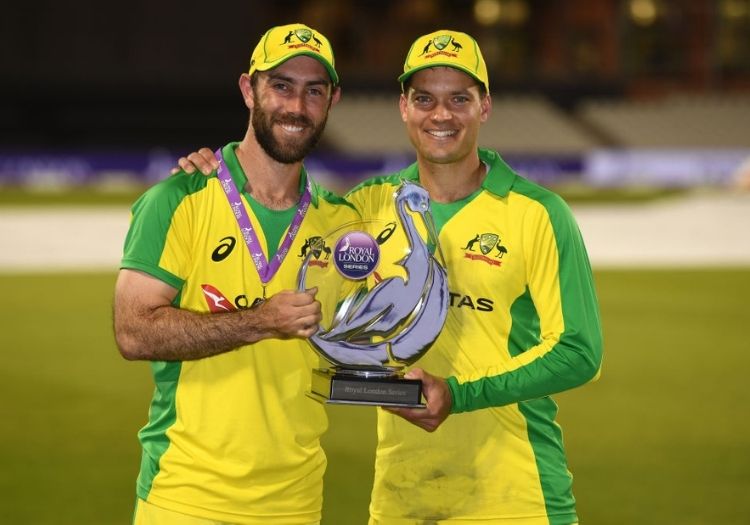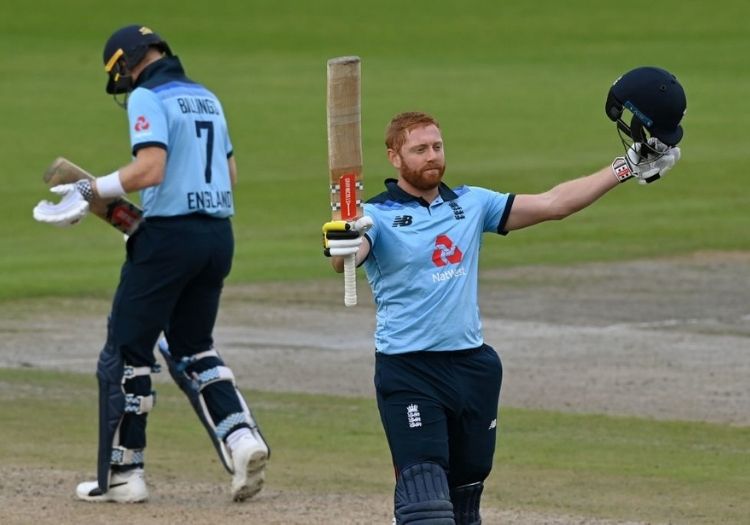NICK FRIEND: When Alex Carey and Glenn Maxwell came together, Australia were in some substantial disarray. By the time they were separated, they had all but finished the job - a task left to Mitchell Starc to complete with clinical aplomb


The game was over, the series done, Australia blown away once more, having let slip a winning position only to flounder meekly to their world champion opponents.
And then suddenly, it all changed. There was a chance each: one taken but rescinded thanks to a no-ball from Jofra Archer, the other shelled by Jos Buttler, who snatched at a thin edge from Glenn Maxwell.
But other than these two moments, this was a flawless, faultless, extraordinary swig of courage from two men under pressure to work wonders. What began – pinned to the ropes – as a counterpunch from the canvas ultimately became something more: a collection of jabs, hooks and much more.
Their job was not simply to take their side to victory, but first to lift them from the abyss. And then, to accomplish everything else in between – sprinting on eggshells, dodging bullets, dancing on hot coals but without ever getting burnt. The game was on them, and they delivered.
Maxwell is a freak – a genius blessed at times with too much ability for his own good. He had threatened to do this throughout the tour; it is no coincidence that in Australia’s victory in the first ODI, he made another valuable contribution with the bat.
Carey is similar. English cricket has not seen the best of him this summer, but tonight was treated to a version much more like the impressive wicketkeeper-batsman who left a mark on last year’s World Cup.
And together, they forged an ideal partnership for the circumstances – the combination of left-hander and right-hander meaning that Australia never once lost the benefit of hitting to the short boundary on one side of the ground. And faced with vast swathes of outfield to the other side, the pair ran like their lives depended on it.
From an Australian perspective, the only disappointment was that neither was there at the end to see their team home. Both deserved that privilege, having laid the groundwork from a position where there was no ground for a memorable scalp.
England hadn’t lost a home bilateral ODI series for five years until tonight. And it took quite something to break that run.

Mitchell Starc struck the winning runs for Australia
On Sunday evening, Australia were 144 for 2, chasing just 232. England were down and out, but then they weren’t.
Eoin Morgan might have admitted that his decision to recall Jofra Archer and Chris Woakes to his attack was a case of last-chances saloon, but nonetheless it was a gamble made with heaps of belief in mind.
And thus, it would have been foolish to write them off three days later, when England when 0 for 2 after 0.2 overs, having just seen the very worst start it is possible to experience in any game of cricket at any level.
Jason Roy, a man short of runs, form and surety, sliced to backward point, before Mitchell Starc thumped into Joe Root’s pads with the very next delivery. Both dismissals were straight from the manual – Roy has a penchant for edging big, booming drives.
His first innings as an ODI cricketer – back in 2015 against New Zealand – brought the exact same demise, scything Trent Boult to gully on that occasion. He has, of course, become a far better player since then and a vital member of England’s white-ball side.
Lest it be forgotten that when his hamstring gave way during the World Cup last year, his absence almost saw the world collapse around his teammates, who struggled without his aura and swagger at the top of the innings.
But it is also important to note how short on runs he has been since then. In eight ODI innings since the World Cup final, he has averaged 12.75; in all competitions this summer – for England, England Lions and Surrey, he has scored 71 runs in nine innings.
One would hope that his past achievements come with some credit in the bank; there are few better to watch in full flight, even fewer who assert such dominance when in control. One extra cover drive against Starc in last year’s World Cup semi-final still stands out – liquid perfection in cricketing form.

Morgan handed Adil Rashid the final over of the series
This has also been a challenging summer for Roy, who missed both T20I series against Pakistan and Australia with a side strain.
One wonders whether it has been easier for those who played in the T20Is to kick themselves into gear for the 50-over games, rather than coming in without having had that benefit. Roy’s numbers this summer don’t make for pretty reading: 0, 24, 0, 1, 4, 14, 3, 21 0 – two months to forget, perhaps.
But England do have options: Dawid Malan has shown his value in T20I cricket but his ODI career is just a single game old; Tom Banton, blooded in the middle order, is an opening batsman; Phil Salt was initially called up to the squad for this series as cover for Roy; Alex Hales remains on the outside banished to the wings.
Even so, from 0 for 2 and 96 for 4, England ended 302 for 7; all this without Ben Stokes and, therefore, a batsman lighter than in normal times. In the history of ODI cricket, no other team has ever passed 300 after being two wickets down without a run on the board.
To a certain degree, it’s a record that Eoin Morgan and England could do without. But by the same token, there is perhaps no statistic that says so much about the attitude and aptitude of this team – that they both skilful enough and sufficiently willing to adjust.
Even on the wrong side of a nail-biting thriller – the kind that England have become so used to winning, they would do well to remember that.
The man with the Midas touch – or rather, the Morgan touch. So often, when he has reached into his hat, he has come out with a rabbit. In the second match of the series, it was Morgan’s decision to bring back Archer and Woakes into the attack that turned the game in England’s favour.
In the decider, there were two calls: one that worked, another that backfired.
First, it was his hunch for Joe Root. And just five balls into the experiment, it paid dividends as David Warner was beaten by a ball that spat off the pitch and turned past his outside edge. Like so much that Morgan touches, it quickly turned to gold.
And then, there was the final piece of intuition, the last act of a tremendous evening of theatre – a call made more difficult by Root’s earlier success. His eight overs meant that Rashid, Mark Wood and Tom Curran could all have bowled the last over.

Jonny Bairstow hit his tenth ODI hundred
There would have been logic to each move; Rashid had done the job in the previous game – albeit when Morgan’s hand had been forced by his tactics through the middle overs; Curran is a fine death-bowler and won a game for England in the preceding T20I series by closing out a tight final over; Wood, too, has previous and had been the most economical bowler on the night.
But Morgan plumped for Rashid, hoping for a mishit to a boundary-rider, a top edge to short third man – the like of which had just seen off Maxwell, a stumping – as per Carey’s match-ending dismissal in the second ODI, or simply for the brilliant mystery of his leg-spinner to deceive Mitchell Starc and Pat Cummins.
And so, it is fair to say that the thinking was sound. It wasn’t perhaps the percentage move that others would have taken, but Morgan will argue that his England side has never founded itself on safe measurements.
Faced with the same dilemma once again, you can bet that Morgan would back his judgement once more.
Jonny Bairstow’s contribution to this game may well get lost in all that followed. His individual series has been a fine advert for the quirks of form and the value of patience and perseverance. In the third T20I, he had battled desperately and painstakingly for fluency, finally being put out of his misery once he had used up 44 balls for his 55.
And off the back of that, he began the first ODI in rotten touch, watching wickets fall around him as England attempted in vain to chase down a big score.
On that occasion, he reached his half century in 78 balls, before finally falling for 84 off 107 deliveries. This time around, he watched as Roy and Root were dismissed before he had even had a chance to face up himself.
But when he did – alongside Morgan, he reaped the rewards of his earlier tenacity.
For unrivalled coverage of the county season, subscribe to The Cricketer and receive 3 issues for £5
Subscribe to The Cricketer for exclusive content every day: The inside track on England's Test tour with George Dobell in Pakistan, award-winning analysis, breaking news and interviews and the only place for in-depth county coverage all year round. Plus: An ad-free app experience at your fingertips. Subscribe to thecricketer.com today for just £1.